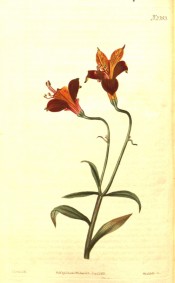Alstroemeria ligtu subsp. simsii (Spreng) Ehr.Bayer
The species, Alstroemeria ligtu, has lance-shaped leaves, to 8cm long, and umbels of up to 24 flowers, whitish or pale lilac or pale red outside, yellow inside, spotted or streaked with white, purple or red, borne on stems to 80cm long, in summer. The Botanical Magazine illustrtation of A. pulchella shows a distinctive deep reddish flower with deep red striations to the petals. [RHSD, Hortus, Baker Am.].
See also Alstroemeria pulchella L.f.
Horticultural & Botanical History
First described as Alstroemeria pulchella by Sims in the Botanical Magazine in 1822 [BM t.2353/1822]. Described and named Alstroemeria simsii by Sprengel in 1825 [Systema Vegetabilium vol.2, p.80/1825] and as Alstroemeria ligtu subsp. simsii by Ehrentraut Bayer in 1987 [Die Gattung Alstroemeria in Chile p.144/1986 (1987)]. This is the name now generally accepted.
Curtis's Botanical Magazine, while acknowledging the confusion in nomenclature, recommends retaining the name A. pulchella for the plant it describes and figures under the name ‘Alstroemeria pulchella, Speckled Alstroemeria’. ‘Although we have very little doubt but that our plant is the same species as that described and figured by Father Feuillée, and referred to by Linnaeus as a synonym for A. ligtu, and consequently that the species published under that name at t.125 of this works, is not the original ligtu; yet as that plant is now well known in Europe by that name, we think that any attempt to restore the original appellation, were we quite certain of the errors, would only add to the confusion. Not to increase unnecessarily the number of species, we refer our plant to A. pulchella, under which name we received it, though we confess that it does not well agree with the description in the Supplementum Plantarum; and we do this the more readily as there is no species described in the Flora Peruviana by the name of pulchella, which was taken up by Linnaeus from a drawing only. There is no figure of Alstroemeria ligtu in the Flora Peruviana of Ruez [sic] and Pavon, the drawings and dried specimens of that plant being lost by shipwreck, but their description disagrees in very few points with our present subject; and they refer to Feuillee's figure without stigmatising it as bad; a character given it by Willdenow, and which it well deserves, if intended to represent the plant now known by that name. The specimens preserved in their Herbarium now in the possession of Mr. Lambert, as A. Ligtu, are more like our plant than the one which is so called at present; but perhaps may be only varieties of Pelegrina.’ [BM t.2353/1822]. Alstroemeris pulchella Sims, the plant described above, is now considered to be Alstroemeria ligtu subsp. simsii (Spreng.) Her. Bayer.
The Botanical Register also figures ‘Alstroemeria pulchella, Red Speckled-flowered Alstroemeria’, with an illustration strikingly similar to that in the Botanical Magazine [BR f.1008/1827]. The Botanical Register also figures Alstroemeria pulchella var. pilosa, now recognised as Alstroemeria ligtu subsp. simsii (Spreng.) Ehr.Bayer. [BR f.1410/1832]. ‘This lovely plant [Alstroemeria pulchella var. pilosa] is so liable to vary, that we have thought it right to publish a form in which it is strikingly different from its appearance as represented at fol. 1008. In the latter the leaves are so little pubescent as to appear almost smooth, and the sepals so slightly denticulate as to be little more than scabrous at the margin. In this, on the contrary, the hairs of the leaves are remarkably long, and the sepals deeply and distinctly serrated; the flowers are also larger, and more brightly coloured. Our drawing was made from a plant in the Garden of Lady Oakes, at Mitcham, where it flowered beautifully in a pot last autumn. Many of the species of Alstromeria are very apt to die under the hands of cultivators: this is, however, one of the most easily managed. It is nearly hardy, and would probably prove quite so if grown oh a south border, covered in winter by a wide sloping thatched roof, such as is now in use, with great success, in the Garden of the Horticultural Society. But the safest way to treat the species is to plant them in light loamy soil, in a border within a glazed pit which is just heated. Here they will grow with great vigour, throwing up strong suckers in all directions, and flowering beautifully: their leaves will not, on the one hand, be parched by the drying cold winds of April, nor, on the other, scorched by the sun at Midsummer. Thus protected, they will perform all their natural functions as if in their native soil; and an abundance of food will be sent downwards into the roots, which will thus be prepared, upon the return of the growing season, to send up new shoots with the greatest vigour.’ [BR f.1410/1831].
History at Camden Park
Listed in all published catalogues under the name Alstroemeria pulchella. [B.28/1843]. See also Alstroemeria pulchella L.f., a possible identification for this plant.
Notes
Alstroemeria pulchella H.Vilm. = Alstroemeria aurea Graham which also see.
Published Jan 11, 2009 - 03:19 PM | Last updated Apr 03, 2012 - 04:57 PM

Alstroemeria ligtu subsp. simsii (Spreng) Ehr.Bayer | BM t.2353/1822 as Alstroemeria pulchella | BHL
| Family | Alstroemeriaceae |
|---|---|
| Category | |
| Region of origin | Chile |
| Synonyms |
|
| Common Name | St Martin’s Flower |
| Name in the Camden Park Record | Alstroemeria pulchella
|
| Confidence level | medium |

